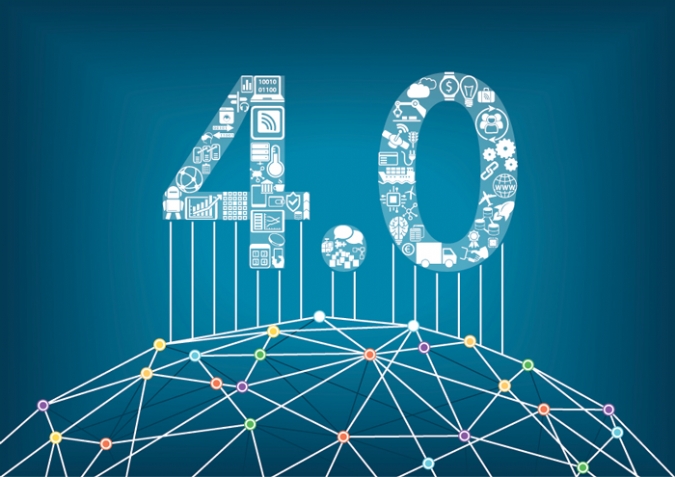Affected by the epidemic situation IAMD BEIJING closed in 2020
Trade News
A future where everyone, and everything, learns
Reprinted from www.thefabricator.com
Industry 4.0
Industry 4.0. We’ve all heard it as being about a world of smart machines and smarter factories. So what does Industry 4.0 mean to you? Several years ago I asked the question at various shops, and I usually got some variation of “It’s nice and everything, but I need to get these jobs out the door.” There’s a change in perception now, though, and that might be because we’re starting to see some elements of the Industry 4.0 picture become reality.

First, let’s back up. Industry 4.0 is just a term. Yes, it does refer to the fourth industrial revolution. The first was mechanization, the second was mass production, the third automation. Read articles about Industry 4.0 and you’ll learn about smart networks arranged in (as it says on top of the Industry 4.0 Wikipedia page) “cyber-physical systems.” Well, OK, that’s nice. But I’ve got to get jobs out the door.
The world of Industry 4.0 is a little like a painter with amazing colors (cyber-physical systems, artificial intelligence, cloud computing—choose your buzzword), yet has only a really small canvas to work with (the early technology adopters and platforms). Grow the canvas, and the colors really start to blend (more adopters mean more data, boosting system learning), and only then do you realize how amazing the resulting picture can be.
The size of the canvas matters. Not long ago the canvas was small, much of it an enhancement of predictive maintenance. If you connect a lot of machines and add the power of cloud computing, you can predict failures before they happen. You can also extract true machine uptime information (OEE) and put together some really effective analyses.
We’ve got some really interesting colors, but again, the canvas is small. Concepts like machine learning thrive on scale. Whenever you work with technology—like when you Google something or talk to Alexa—and the device seems eerily smart, that probably means the tech has been asked to do something similar millions of times before. But at least for now, we don’t have millions of laser cutting machines connected to the cloud and learning autonomously. That’ll happen only after the canvas grows.
What will Industry 4.0 allow fabricators to paint on a larger canvas? That will depend on the painter, of course, but you might think about the following picture. Some colors are already here, like automated quoting, nesting, and bend simulation. But as the technology scales up and the canvas grows, colors will have more room to blend to create vivid images with new hues—making everything a lot smarter.
The picture might start with automated quoting, drawing from shop floor and third-party data analytics. Upon acceptance, the job is scheduled and nested automatically, drawing data not only from the shop floor but from the cloud, be it provided by the machine toolmaker, a third party, or both.
Scheduling and nesting software could also draw from material- and material supplier-specific data; this would make it smart enough to know the implications of nesting long and skinny parts on a certain thickness and grade of a certain mill’s galvanneal that has a history of residual stress. So it would know to nest and microtab in such a way to prevent those long, skinny parts from bowing up after being cut and crashing the machine.
Parts are denested and sorted automatically—again, using data both from the local shop floor and from the cloud—then move on to forming, with bend simulations that consider individual operator preferences as well as the movement of workpieces between each step of a staged bend.
Once parts are formed, they move downstream immediately. Many jobs ship not in weeks or days but in a matter of hours. How can everything flow so smoothly? Because everything is connected, and everything is learning.
Exhibition contact
Hannover Milano Fairs Shanghai Ltd.
301 B&Q Pudong Office Tower 393 Yinxiao Road, Pudong, Shanghai 201234, P.R. China
Contact:
Mr. David Zhang
Mr. Klaus Qian
Mr. Steven Xie
Ms. Jean Ji
Ms. Lia Zhou
Tel: +86 21 2055 7128/7129/7130/7131/7132
Fax: +86 21 2055 7100
Email: ia-beijing@hmf-china.com
Visit Contact :
Ms. Shirley Zhang
Tel: +86 21 2055 7150
Fax: +86 21 2055 7100
Email: shirley.zhang@hmf-china.com
Delegation Contact :
Mr. Zack Jiang
Tel: +86 21 2055 7156
Fax: +86 21 2055 7100
Email: zack.jiang@hmf-china.com
QQ: 1345900360
Skype: zackjiang_hmf
Media Cooperation Contact:
Ms. Paula.Wang
Tel: +86 21 2055 7012
Fax: +86 21 2055 7100
Email: Paula.wang@hmf-china.com
QQ: 1877205992
Hannover Milano Fairs China Ltd. Beijing Branch
Rm.1803 Block A, Langqin International Building, No.168 Guang'anmenwai Ave, Xicheng District, Beijing, China 100055
Contact:
Ms. Amma Feng
Tel: +86 (10) 83065400
Fax: +86 (10) 83065345
Email: ia-beijing@hmf-china.com
Hannover Milano Fairs China Ltd. Guangzhou Branch
Rm.1510, West Tower, Poly World Trade Center, No.1000 Xingang East Road, Haizhu District, Guangzhou, China 510308
Contact:
Ms. Cindy Huang
Tel: +86 (20) 86266696-8015
Fax: +86 (20) 38795750
Email: ia-beijing@hmf-china.com